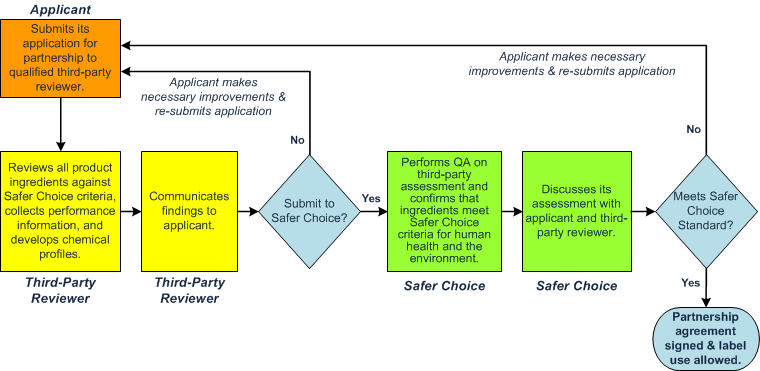Steps to Get the Safer Choice Label on Your Product
- Flowchart of the Safer Choice application process
- How to apply for the Safer Choice label
- Design for the Environment logo for pesticide products
- How to start a partnership for a new category of products
Steps to Partnership Flowchart
See a text-only version of the flowchart.
How to apply for the Safer Choice label
STEP 1. Become Familiar with the Program
If you're a product manufacturer, read the Safer Choice Standard, the Criteria for Safer Chemical Ingredients, and the Safer Choice Product-Class Criteria to get a sense of the program's goals, framework, criteria, and to determine if your product may qualify to bear the Safer Choice label.
Consult EPA's Safer Chemical Ingredients List (SCIL) and GreenBlue's CleanGredients® to find safer chemical alternatives for your formulation.
STEP 2. Profiling of All Formulation Ingredients
Applicants for the Safer Choice label must fully disclose all ingredients in their product under consideration to Safer Choice and to a Safer Choice-qualified third-party profiler. For proprietary or trade-name ingredients, the third-party profiler will contact suppliers to get necessary information.
The third-party profiler compiles all hazard information available on each chemical, including detailed structure, physical-chemical properties, human health and environmental toxicology, and regulatory/administrative status. This compilation of data is known as a profile. Qualified third-party profilers have the expertise and objectivity needed to ensure a quality review, with high confidence in its accuracy and reliability. Read the qualifications for third-party profilers.
Safer Choice's authorized third-party profilers are Gradient Corporation; NSF International; and ToxServices, LLC. Please contact them directly for information on how to submit your product information and for price quotes.
- Gradient
Please contact Kim Reid at (617) 395-5577 or kreid@gradientcorp.com,
or visit Gradient's website Exit - NSF International
Please contact Leslie Dietrich at (734) 214-6244 or sustainability@nsf.org,
or visit NSF's website Exit - ToxServices, LLC
Please contact Erica Harriman at (202) 429-8789 or eharriman@toxservices.com,
or visit ToxServices' website Exit
STEP 3. Assessing Ingredients and Identifying Safer Alternatives
Following third-party profiling, Safer Choice:
- Assesses each ingredient in your formulation in the context of its functional class; and
- See the Criteria for Safer Chemical Ingredients for functional-class criteria (e.g., solvents, surfactants, chelating agents, and fragrances).
- See the Master Criteria for chemicals where specific functional-class criteria have not yet been defined.
- Identifies areas for improvement, safer alternatives, or additional information needs.
STEP 4. Discussing the Safer Choice Assessment
After the product assessment, Safer Choice and the third-party profilers communicate to the applicant on the review’s outcome. In addition to the product and ingredient profiles, the exchange would include any recommendations for improvement, formulation changes necessary to qualify for recognition, and consideration for entering into partnership.
For qualifying products, Safer Choice and the applicant discuss the elements of a partnership agreement, including key user and environmental benefits, ingredient disclosure, and company signatory.
STEP 5. Entering into Partnership
After the product manufacturer has satisfied Safer Choice's requirements for the use of safer ingredients, Safer Choice and the manufacturer sign a partnership agreement. The purpose of the partnership agreement is to set forth the basis, terms, and goals of the Safer Choice's voluntary partnership between the partner and EPA. The partnership agreement includes provisions covering the following:
- How the partner formulates the qualifying products;
- Their environmental and human health benefits; and
- How the partner and EPA/Safer Choice will work together to continually improve the health and environmental profile of the qualifying products and educate consumers on the importance of safer products and the role of the Safer Choice Program.
See a sample Safer Choice partnership agreement.
Safer Choice and your company decide how to announce the partnership and plan near-term activities. Safer Choice welcomes additional products for review, as well as your ideas on how to improve and strengthen the partnership program. Your company should carefully review the "Safer Choice Branding Guidelines" provided to you at the start of the partnership.
Please note: Submission of data under this program is voluntary.
Design for the Environment Logo for Pesticide Products
To learn about the Design for the Environment (DfE) logo for pesticide products please visit the Office of Pesticide Program's DfE Logo for Pesticide Products webpage or contact DfE Support (DfEsupport@abtassoc.com).
How to start a partnership for a new category of products
Companies interested in developing a new product sector, or class of products, that Safer Choice has not previously labeled, should contact the program directly at saferchoice@epa.gov. Before you write, please review the list of product categories to determine if your product represents a new category or might fit within a current category.
The Safer Choice Program reviews and recognizes best-in-class chemical-based formulations and products that meet its stringent criteria. Because the program's expertise is chemistry, Safer Choice limits its partnership activities to manufacturers of chemical-based products.
The Office of Management and Budget (OMB) has approved Safer Choice Program collections of information, as defined by the Paperwork Reduction Act (44 U.S.C 3501 et seq.), under OMB Control No. 2070-0178, valid until 5/31/2022.

